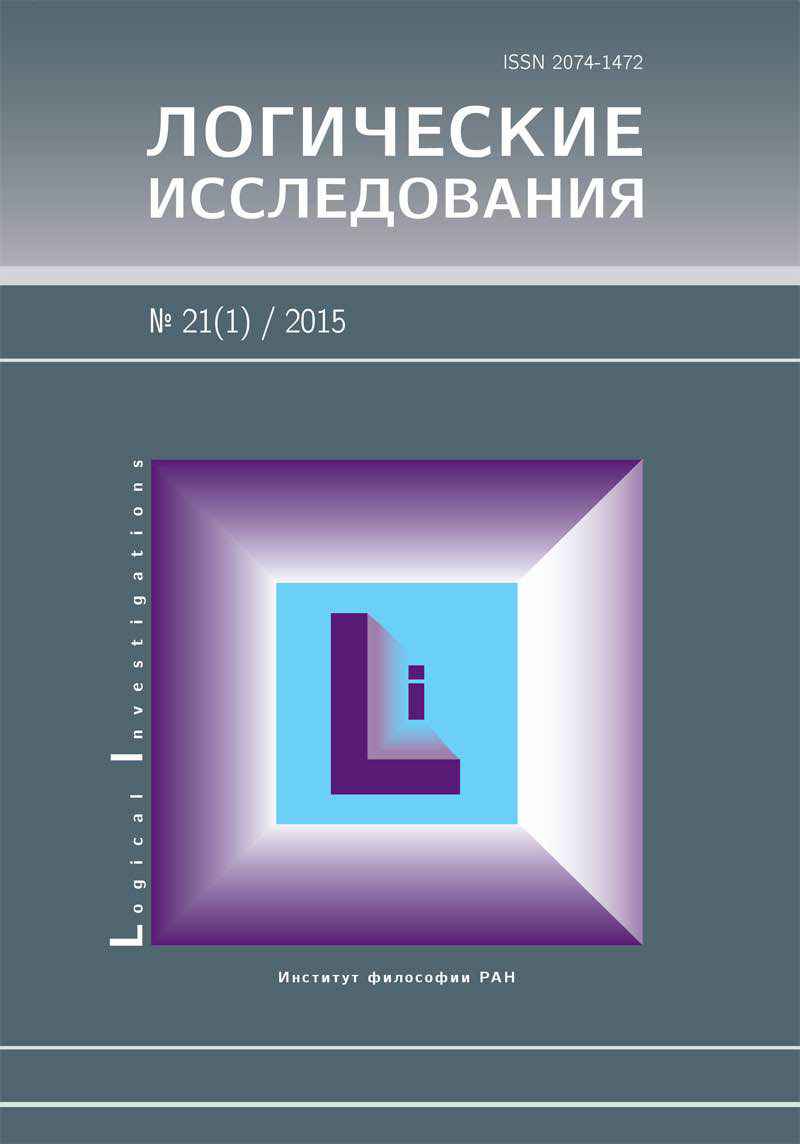Two Approaches to Philosophically Analyzing Language
##plugins.themes.bootstrap3.article.main##
Abstract
According to some philosophers we can distinguish two trends in dealing with (especially natural) language. One of them is older and uses explications that simplify the richness of the language, so that the result of its efforts is an artificial image of language not corresponding to its real shape. The more recent trend tries to capture all the richness of the language together with all its irregularities and is represented mainly by Quine’s and later Wittgenstein’s philosophy. The older trend (I call it $\textit{analytic group}$, $\textbf{AG}$, here) is sometimes criticized as being somehow obsolete while the more recent trend (called here $\textit{Q-W group}$, $\textbf{Q-W}$, here) is then evaluated as more promising (more ‘progressive’). I try to show that $\textbf{AG}$ is incomparable with $\textbf{Q-W}$ because both try to answer distinct questions, solve distinct problems. (A comparison could be realized on the higher level of evaluating the choice of problems itself, which is another topic.)
##plugins.generic.usageStats.downloads##
##plugins.generic.usageStats.noStats##
##plugins.themes.bootstrap3.article.details##
How to Cite
Materna P. Two Approaches to Philosophically Analyzing Language // Logicheskie Issledovaniya / Logical Investigations. 2015. VOL. 21. № 1. C. 144-154.
Issue
Section
Papers
References
Anderson, C.A. “Alonzo Church’s contributions to Philosophy and Intensional Logic”, The Bulletin of Symbolic Logic, 1998, vol. 4, no 2. pp. 129–171.
Beran, O. “Stredni” Wittgenstein: cesta k fenomenologii a zase zpatky. Cerveny Kostelec: Nakladatelstvi Pavel Mervart, 2013. 252 pp.
Bolzano, B. Wissenschaftslehre I. Sulzbach: J.E. v. Seidel, 1837. 730 pp.
Carnap, R. Meaning and Necessity. Chicago: University of Chicago Press, 1947. 231 pp.
Carnap, R. Logical foundations of probability. Chicago: University of Chicago Press, 1950. 630 pp.
Church, A. Introduction to Mathematical Logic. Princeton: Princeton University Press, 1956. 378 pp.
Church, A. “A Revised Formulation of the Logic of Sense and Denotation. Alternative (1)”, Nous, 1993, vol. 27, no 2, pp. 141–157.
Cresswell, M.J. “Hyperintensional logic ”, Studia Logica, 1975, vol. 34, Issue 1, pp. 25–38.
Duzi, M., Jespersen, B., Materna, P. Procedural Semantics for Hyperintensional Logic. Foundations and applications of Transparent Intensioanl Logic. Berlin: Springer, 2010. 565 pp.
Frege, G. Die Grundlagen der Arithmetik. Breslau: W. Koebner, 1884. 119 pp.
Frege, G. “Uber Sinn und Bedeutung”, Zeitschrift fur Philosophie und philosophische Kritik, 1892, vol. 100, pp. 25–50.
Geach, P. Black, M. Translations from the Philosophical Writings of Gottlob Frege. Oxford: Basil Blackwell, 1952. 250 pp.
Gamut, L.T.F. Logic, Language, and Meaning, Volume 2: Intensional Logic and Logical Grammar. Chicago: The University of Chicago Press, 1991. 366 pp.
Kaplan, D. “Dthat”, Syntax and Semantics, vol. 9, ed. P. Cole. New York: Academic Press, 1990. pp. 212-223. Reprinted in: Demonstratives, ed. by P. Yourgrau. Oxford: Oxford University Press.
Kripke, S. “Semantical considerations on modal logic”, Acta Pilosophica Fennica, 1963, vol. 16, pp. 83–94.
Kripke, S. Naming and Necessity. Oxford: Basil Blackwell, 1980. 184 pp.
Quine, W.V.O. From a logical point of view. New York and Evanston: Harper & Row Publishers INK, 1953, 1961. 184 pp.
Quine, W.V.O. Word and Object. Cambridge: MIT Press, 1960. 264 pp.
Tichy, P. The Foundations of Frege’s Logic. Berlin, New York: De Gruyter, 1988. 303 pp.
Tichy, P. ‘Constructions as the subject-matter of mathematic’, The Foundational Debate: Complexity and Constructivity in Mathematics and Physics, eds. W. De Pauli-Schimanovich, E. Khler and F. Stadler. Dordrecht, Boston, London, and Vienna: Kluwer, 1995, pp. 175–185.
Wittgenstein, L. Philosophical Investigations. Oxford: Basil Blackwell, 1968. 250 pp.
Beran, O. “Stredni” Wittgenstein: cesta k fenomenologii a zase zpatky. Cerveny Kostelec: Nakladatelstvi Pavel Mervart, 2013. 252 pp.
Bolzano, B. Wissenschaftslehre I. Sulzbach: J.E. v. Seidel, 1837. 730 pp.
Carnap, R. Meaning and Necessity. Chicago: University of Chicago Press, 1947. 231 pp.
Carnap, R. Logical foundations of probability. Chicago: University of Chicago Press, 1950. 630 pp.
Church, A. Introduction to Mathematical Logic. Princeton: Princeton University Press, 1956. 378 pp.
Church, A. “A Revised Formulation of the Logic of Sense and Denotation. Alternative (1)”, Nous, 1993, vol. 27, no 2, pp. 141–157.
Cresswell, M.J. “Hyperintensional logic ”, Studia Logica, 1975, vol. 34, Issue 1, pp. 25–38.
Duzi, M., Jespersen, B., Materna, P. Procedural Semantics for Hyperintensional Logic. Foundations and applications of Transparent Intensioanl Logic. Berlin: Springer, 2010. 565 pp.
Frege, G. Die Grundlagen der Arithmetik. Breslau: W. Koebner, 1884. 119 pp.
Frege, G. “Uber Sinn und Bedeutung”, Zeitschrift fur Philosophie und philosophische Kritik, 1892, vol. 100, pp. 25–50.
Geach, P. Black, M. Translations from the Philosophical Writings of Gottlob Frege. Oxford: Basil Blackwell, 1952. 250 pp.
Gamut, L.T.F. Logic, Language, and Meaning, Volume 2: Intensional Logic and Logical Grammar. Chicago: The University of Chicago Press, 1991. 366 pp.
Kaplan, D. “Dthat”, Syntax and Semantics, vol. 9, ed. P. Cole. New York: Academic Press, 1990. pp. 212-223. Reprinted in: Demonstratives, ed. by P. Yourgrau. Oxford: Oxford University Press.
Kripke, S. “Semantical considerations on modal logic”, Acta Pilosophica Fennica, 1963, vol. 16, pp. 83–94.
Kripke, S. Naming and Necessity. Oxford: Basil Blackwell, 1980. 184 pp.
Quine, W.V.O. From a logical point of view. New York and Evanston: Harper & Row Publishers INK, 1953, 1961. 184 pp.
Quine, W.V.O. Word and Object. Cambridge: MIT Press, 1960. 264 pp.
Tichy, P. The Foundations of Frege’s Logic. Berlin, New York: De Gruyter, 1988. 303 pp.
Tichy, P. ‘Constructions as the subject-matter of mathematic’, The Foundational Debate: Complexity and Constructivity in Mathematics and Physics, eds. W. De Pauli-Schimanovich, E. Khler and F. Stadler. Dordrecht, Boston, London, and Vienna: Kluwer, 1995, pp. 175–185.
Wittgenstein, L. Philosophical Investigations. Oxford: Basil Blackwell, 1968. 250 pp.
